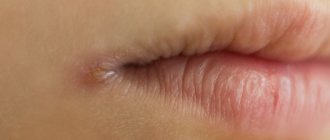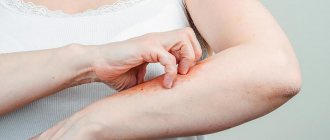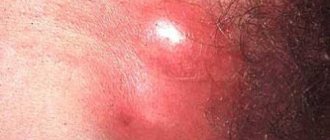You are in the section: Home » Articles » DERMATOLOGY: inguinal athlete's foot (dermatomycosis)
Review
Athlete's foot (also known as tinea inguinalis, eczema fringe, ringworm, Tinea cruris, etc.) is a fungal infection of the trichophytosis class caused by Trichophyton, Microsporum and Epidermophyton fungi that affects the skin of the groin area, including the genitals, inner thighs and buttocks.
Skin lesions manifest themselves in the form of an itchy red, often ring-shaped rash, predominantly located in the warmest and most humid areas of the human body that are constantly covered by clothing. Tinea groin is common in people who sweat a lot, such as athletes. It is also more common in overweight people.
This disease, as a rule, is not serious, although it causes a lot of inconvenience to its carriers. For cure, it is usually sufficient to maintain hygiene of the groin area and use local antifungal drugs.
Symptoms
Fringed eczema usually begins as a red patch of skin that spreads from a crescent-shaped crease in the groin to the upper thigh. The border of the rash may consist of a line of small blisters. The rash often itches or burns, and the skin may peel or become scaly. This, by the way, is where the names groin itching or lichen come from.
When to see a doctor
Call your doctor if you have a skin rash that does not go away on its own within two weeks, or if it appears again within a few weeks of finishing over-the-counter medications.
Causes
Athlete's foot is caused by fungi that can be spread from person to person through direct contact or by sharing contaminated towels or clothing. Tinea cruris in athletes is often caused by the same fungus that infects the feet and causes athlete's foot (Tinea pedis). Usually in these cases the infection is transferred from the foot to the groin folds through the hands or wet towels.
Risk factors
Microorganisms that cause itching in the groin prefer the moist environment of skin folds and hidden places of the human body. Those most at risk are:
- men;
- teenagers or young adults;
- lovers of wearing tight underwear;
- are overweight;
- sweating heavily;
- having a weakened immune system;
- susceptible to diabetes (excessive urination in diabetes insipidus).
Prevention
To reduce your risk of developing athlete's foot, simply follow these principles:
Maintain good body hygiene . It is important to keep the groin area clean and dry. Dry the genital area and inner thighs thoroughly after showering with a clean, ironed towel. To prevent diaper rash, use powder in the groin area.
Wear clean clothes . If you sweat a lot, change your underwear at least once a day or more often. Wash your workout clothes after each use.
Choose clothes that fit . Make sure clothes fit your body, especially underwear and sportswear. Avoid tight-fitting clothing, which can chafe and itch your skin. Try wearing boxer shorts instead of briefs and trunks.
Don't share personal items . Do not allow others to share your clothing, towels, or other personal items. And do not take these items from others yourself.
Treatment of athlete's foot . Control foot infections to prevent them from spreading higher into the groin area. If you frequently visit public places, such as gym showers, public saunas and steam baths, wearing sandals will help prevent athlete's foot infection.
Diagnostics
In most cases, diagnosing tinea groin is not difficult. To determine the disease, simply look at the rash. If the diagnosis is not clear, the doctor may take skin scrapings or samples from the affected area and examine them under a microscope. To rule out other pathologies, your doctor will likely send the sample to a laboratory for culture.
Treatment
For mild tinea groin, your doctor may suggest using an over-the-counter antifungal ointment, lotion, powder, or spray first. With these treatments, the rash may disappear fairly quickly, but you must continue to use the drug as directed for one to two weeks. If tinea pedis is also detected, it is necessary to treat both of these diseases simultaneously. An integrated approach will significantly reduce the risk of relapse.
For severe ringworm or a form of the disease that is resistant to over-the-counter medications, prescription creams or ointments or even antifungal tablets may be needed.
Treatment of severe inguinal athlete's foot, complicated by tinea pedis or other underlying disease, as well as the consequences of self-medication, can take a long time and require a certain amount of patience from the patient. However, it is not incurable and is quite successfully treated by experienced dermatologists at the Clinic of Dr. Filatov.
Types of fungal infections
Three types of fungi live in the human body:
- yeast;
- moldy;
- domiformes.
Only the first variety is considered opportunistic: such microorganisms cause harm only if immunity is reduced and metabolism is disrupted. As for the other two types of fungi, they are always dangerous to health.
Depending on the pathogen, fungal infections such as:
- Candidiasis. Yeast fungus of the genus Candida affects the skin and mucous membranes.
- Trichophytosis, or ringworm. The pathogenic microorganism trichophyton causes damage to hair, nails, and skin.
- Dermatophytosis. A fungus of the genus Arthodermataceae parasitizes the scalp, skin and nails.
- Keratomycosis. The causative agents are Aspergillus and Actinomycetes. The stratum corneum of the skin suffers from them.
Fungal diseases can affect fingers and toes, nails, hands, feet, hair and so on. Pathogens also penetrate the vagina, throat, intestines and other internal organs.
Different types of mycoses have special symptoms, but they also have characteristic manifestations. At the beginning of the disease, the affected area peels off, turns red and becomes inflamed. Then small bubbles appear. They burst, and in their place erosions form, which itch and hurt. The skin becomes loose and even begins to peel off.
Treatment of candidiasis
Treatment of candidiasis is aimed at eliminating factors that contribute to the occurrence of candidiasis. If the skin is affected, local treatment is carried out using an open method using antifungal ointments.
The attending physician prescribes systemic and local medications for this disease. Local agents are not absorbed into the blood - they act only on the mucous membrane affected by the Candida fungus. They stop the reproduction and growth of fungi, relieve discomfort and restore affected tissue.
Why are fungal infections dangerous?
Mycoses have a variety of symptoms. Almost always there is severe itching, an unpleasant odor, and possible pain.
However, the main danger is that fungi quickly spread throughout the body and affect new areas. A systemic infection cannot be ruled out when pathogens penetrate deeply into tissues and organs. The patient experiences weakness, pain, suffers from digestive disorders, toxicosis, and skin rashes.
Without the help of a specialist, the disease worsens and becomes chronic with frequent exacerbations. In the most severe cases, sepsis and death cannot be ruled out. The sooner you see a doctor, the easier it will be to get rid of pathogenic flora.
Home remedies cannot cure the infection. At best, it will go into “sleep” mode. The patient is not able to independently identify the pathogen and, accordingly, choose the correct treatment method.
Why do they trust us to treat fungal diseases?
The medical department employs qualified dermatovenerologists. Our doctors - V. A. Malashenko and R. A. Guseinov - specialize, among other things, in mycology, so they accurately diagnose and prescribe optimal treatment.
Accurate identification of the pathogen plays an important role in removing fungus. We perform tests that reveal:
- presence of a pathogen;
- its appearance;
- quantity;
- sensitivity to certain antifungal drugs.
Fungi are studied using various methods - microscopy, PCR, inoculation on nutrient media. The availability of options allows you to choose the most suitable one for a particular patient.
Based on the results of the analysis, our specialists create a comprehensive treatment regimen. As a rule, it includes oral antifungal drugs, as well as topical agents. By following doctors' prescriptions, you will completely get rid of the infection, and the affected areas will restore their integrity.
An appointment with a dermatovenerologist at the clinic on Tretyakovskaya costs 1,500 rubles. We work at convenient times, seven days a week.
Candidiasis in the groin: methods of diagnosis
Before starting treatment for groin candidiasis, it is necessary to confirm the diagnosis.
This is not always easy, especially if the patient may have pathologies that resemble a candida infection in their symptoms.
First of all, an inspection is carried out.
Based on the results, the doctor evaluates the rash, the severity of swelling and other symptoms.
After this, the question of how to differentiate candidiasis using laboratory methods is resolved.
First of all, the patient is recommended to undergo a smear test.
In women, a smear is taken quite easily.
Men will have to endure several unpleasant minutes.
However, the effectiveness of collecting material in terms of diagnostics is high, and therefore you should not refuse.
The resulting smear can be examined in several different ways.
Most often, in addition to microscopy, sensitivity culture is performed.
Thanks to him, the doctor receives information about what medications can be used to treat the disease, and also confirms the diagnosis.
Additionally, PCR tests and scrapings are often done.
Additional research is especially important in doubtful cases.
When a patient, for example, also has symptoms of inguinal athlete's foot or an allergic reaction, and it is necessary to differentiate the diseases from each other.
In children, it is especially important to pay attention to analysis.
Diaper rash and allergies in the groin area are similar to candidiasis.
Treatment of fungal skin diseases
The cause of dermatomycosis is infection by pathogenic microorganisms. For a person to get sick, contact with infected objects is enough - shoes, towels, washcloths, and so on. The risk of infection is high in people who suffer from sweating feet, varicose veins, diabetes, endocrine disorders and other diseases that reduce immunity.
In our “Polyclinic +1”, appointments are conducted by first category doctors V. A. Malashenko and R. A. Guseinov. They have specialties such as dermatology and mycology. Each of these doctors has many years of practical experience, so they are able to cope with the most difficult cases.
We offer several types of tests for pathogenic flora. Scrapings from the affected area are studied using various methods, including:
- microscopy;
- PCR;
- sowing on nutrient media.
These studies will allow you to identify the fungus, determine its type, and find out what drugs it reacts to.
After this, our doctors draw up a treatment plan for the fungal infection. We practice an integrated approach, so we combine tools that solve different problems:
- destroy harmful microorganisms,
- strengthen the immune system;
- heal the skin.
The duration of therapy depends on the severity of the disease, the body’s resistance and other factors. In any case, our specialists monitor the process and, if necessary, adjust the assignments.
Treatment of genital fungal diseases
Both women and men are susceptible to fungal genital infections. The causative agents of the disease are Candida yeast fungi. They are present in minimal concentrations in the body of almost 80% of people. Under unfavorable conditions, pathogens multiply and infect the genitals.
Factors that activate the growth of fungi are:
- metabolic failure;
- uncontrolled use of antibiotics, hormonal drugs;
- injuries and operations;
- constant stress;
- climate change;
- neglect of personal hygiene.
Pregnant women and people with endocrine, sexually transmitted and infectious diseases are also at risk.
In patients of both sexes, genital mycosis is manifested by symptoms such as:
- skin irritation and redness;
- unbearable itching of the mucous membranes;
- pain during urination or sexual intercourse.
Erosions, spots, and ulcers often appear on the genitals.
Women note a cheesy discharge that has an unpleasant odor. The labia become red and swollen. Constant itching leads to irritability, fatigue, and insomnia.
Fungal diseases of the penis are accompanied by swelling of the foreskin and redness of the urethral sponges. A thick white coating, redness, and erosion appear on the head. The skin of the penis may become cracked, and sometimes there is growth of lymph nodes in the groin. After a night's sleep, there is discharge from the urethra.
Genital fungal diseases themselves cause great discomfort. However, they are also dangerous due to their complications. Self-medication or failure to consult a doctor in a timely manner risks that the infection will penetrate the internal organs of the genitourinary system. This will result in various diseases, in particular infertility.
Recommendations for the prevention of candidiasis in the groin
Genital candidiasis is one of those diseases whose development is much easier to prevent.
What then to do with long and rather expensive treatment, as well as get rid of side effects.
To prevent infection, people should follow the following recommendations:
- When having sex, follow basic safety rules, without refusing to use condoms, especially if you are not completely confident in your partner’s health
- Always remember personal hygiene by not using other people's items from this area
- When visiting public swimming pools and baths, rinse thoroughly in the shower after sessions
- When taking glucocorticosteroids, antibiotics and immunosuppressants, carefully observe the dosage and duration of therapy as recommended by the attending physician
- promptly treat identified diseases of the genital organs, not only infectious, but also of other origins
- devote time to hardening the body so that the immune system does not weaken under the influence of stress and other negative environmental factors
- treat diseases of the endocrine system in a timely manner; if you have diabetes, make efforts to take the disease under control
Unfortunately, doctors note, even following these simple recommendations cannot protect against candidiasis 100%.
However, if you follow these recommendations, the likelihood of encountering the disease during your life will be significantly reduced.
How to cure a fungal genital infection?
Dermatovenerologists at the Polyklnika+1 clinic are fluent in the specialty of mycology. That is why you will receive qualified diagnostics and treatment from us.
Doctors of the first category V. A. Malashenko and R. A. Guseinov use modern methods to detect mycosis at an early stage, even if it is disguised as a bacterial STI. We carry out research:
- an imprint from the glans penis, labia, foreskin, as well as scraping of scales from skin rashes using microscopy;
- smear from the vagina, urethra, cervical canal;
- Fungal DNA in mucosal scrapings (PCR method).
The results of these tests are ready in half an hour or the next day. In addition, within seven days you will receive a response to sowing the biomaterial on nutrient media. Such a study allows us to determine the type of pathogen, its quantity and the degree of sensitivity to drugs.
Guided by the results of the research, specialists at the Tretyakovskaya clinic are drawing up a comprehensive treatment regimen for fungal infections of the genital organs. They take into account factors such as:
- severity of inflammation;
- damage to the mucosa;
- presence of edema.
In accordance with this, the patient is prescribed antifungal, antibacterial, hormonal, wound-healing drugs - in the form of tablets, ointments, intravenous injections. If necessary, immunomodulators and probiotics are prescribed.
The treatment process takes from a week to several months, depending on the severity of the disease. Thanks to the experience and knowledge of our doctors, therapy gives excellent results and minimizes the possibility of relapse.
Modern ideas about the treatment of urogenital candidiasis
Urogenital candidiasis is a fungal disease of the mucous membranes and skin of the genitourinary organs, caused by yeast-like fungi of the genus Candida.
Currently, more than 170 biological species of yeast-like fungi have been described, of which the causative agents of urogenital candidiasis are: C. albicans - in 80% (abroad - in 45-70%), C. glabrata - in 15-30%, C. tropicalis, C. krusei, C. parapsilosis - in 4–7% of cases.
The disease affects both men and women, but is more common in women of reproductive age. In terms of prevalence, vulvovaginal candidiasis ranks second among all vulvovaginal infections. The peak incidence is observed at 20–45 years of age.
Sexual transmission of infection occurs in 30–40% of cases. More often (60–70%) the disease is caused by endogenous infection. During pregnancy, the incidence increases by 10–20%; the risk of transmission of infection to the newborn during childbirth is approximately 70–85%.
Risk factors usually include pregnancy, the use of hormonal contraception and hormone replacement therapy (especially first-generation hormonal drugs), long-term and unsystematic use of antibiotics, immunosuppressants, cytostatics and some other drugs. However, it should be noted that antibacterial agents act as a risk factor only against the background of existing candidiasis and their effect is short-lived. Disorders of carbohydrate metabolism caused by diabetes mellitus contribute to the persistent course of urogenital candidiasis with frequent relapses that are difficult to treat.
Immunodeficiency conditions, systemic diseases leading to immune deficiency, also provoke the occurrence and recurrence of urogenital candidiasis. Candida infection is especially severe in HIV-infected patients. Often, in the terminal stage of AIDS, a generalized candida infection develops.
The main pathogenetic factors traditionally include an imbalance of the vaginal microflora, an increase in the concentration of estrogen and progestins in the tissues, and a violation of the local immunity of the genital tract.
Vulvovaginal candidiasis is the most commonly used name for the disease, since its main clinical manifestations are vulvitis and vaginitis. However, according to localization, candidal cervicitis, colpitis, urethritis, and bartholinitis are also distinguished. According to the nature of the course of the disease, they are distinguished:
- acute (fresh, sporadic) candidiasis (lasts no more than 2 months);
- chronic, including: a) recurrent (at least 4 episodes per year); b) persistent (symptoms of the disease persist constantly, somewhat decreasing after treatment).
Acute genital candidiasis is characterized by a pronounced inflammatory picture. The main complaints and symptoms of vulvovaginal candidiasis are itching and burning, constant or worsening in the afternoon, evening, night, after a long walk, and in patients with atopic predisposition - under the influence of many different factors. In the area of the vulva and labia, the itching is usually intense and is accompanied by scratching. Severe, constant itching often leads to insomnia and neuroses. The feeling of itching and burning, pain, especially in the scratching area, interferes with urination and can lead to urinary retention. Soreness and a burning sensation in the vagina intensify during coitus and lead to fear of sexual intercourse and sexual dysfunction (dyspareunia).
The next symptom is leukorrhea. The leucorrhoea is not abundant, white, thick (creamy) or flaky, curdled, filmy, and has a faint, sour odor. They are rarely watery, with cheesy-crumby inclusions. May be completely absent.
When nearby skin is affected, hyperemia, maceration of the skin, individual pustular elements, and itching in the anus are noted.
In patients with a predisposition, candidiasis often recurs, that is, the disease returns after complete extinction of clinical manifestations and restoration of impaired mucosal functions during treatment. If such relapses occur at least 4 times a year, the disease is classified as chronic recurrent vulvovaginal candidiasis. Treatment tactics in this case differ from those for sporadic episodes.
Another form of chronic infection is persistent vulvovaginal candidiasis, in which clinical symptoms persist constantly and only subside somewhat after treatment. Relapses should be distinguished from exacerbations, which develop not after the disease, but against the background of persistent clinical symptoms. Of course, the approach to treatment in this case is somewhat different than in other forms.
If previously the chronicization and recurrence of the disease was explained by reinfection (either endo- or exogenous), now the cause of these phenomena is considered to be the state of the macroorganism, since the same strain of the fungus is constantly released.
In foreign literature, the terms “complicated” and “secondary” vulvovaginal candidiasis are often used. Complicated includes both chronic forms and atypical etiology, pronounced clinical manifestations, course against the background of severe predisposing conditions (diabetes mellitus, cancer, blood diseases, immunodeficiency, including HIV infection), i.e. cases that are difficult to treat .
Secondary vulvovaginal candidiasis usually includes cases of infection occurring against the background of existing non-infectious lesions of the genital organs with lichen planus, Behcet's disease, pemphigoid.
As a rule, symptoms of candidiasis develop quickly, a week before menstruation, and subside somewhat during menstruation. In the chronic persistent form, their intensity increases.
In terms of differential diagnosis, the other two most common vaginal infections, bacterial vaginosis and trichomoniasis, have similar symptoms.
Symptoms of bacterial vaginosis usually appear in the first week of the menstrual cycle and go away on their own in the middle of the cycle. Recurrence of bacterial vaginosis sometimes follows recurrence of vaginal candidiasis.
Acute trichomoniasis is characterized by itching and a more pronounced burning sensation. The discharge is usually more abundant, liquid, and foamy.
Microscopy of a native preparation or a stained smear is the simplest and most accessible method for identifying the fungus, its mycelium and spores. Cultural diagnosis is recommended only in certain cases:
- to confirm the diagnosis with a negative microscopy result and the presence of a typical clinic;
- for species identification in cases of suspected atypical etiology;
- to determine sensitivity to antimycotics (usually together with species identification).
Isolation of more than 1•104 CFU/ml in the absence of clinical symptoms is regarded as asymptomatic colonization (candidate carriage), and treatment is not prescribed (10–25% of the population are transient carriers of Candida in the oral cavity, 65–80% in the intestines, 17% in the detritus of gastroduodenal ulcers). However, in the presence of predisposing (provoking) factors (for example, antibiotic, chemotherapy, radiation, steroid and other immunosuppressive therapy), prophylactic (preventive) treatment is often carried out. Nystatin is a widely used prophylactic drug. However, it is effective for the prevention of candidiasis only in the intestinal lumen. Its systemic absorption is no more than 3–5%, so it is not able to affect fungi that are not in the intestinal lumen. To prevent urogenital candidiasis, preference is given to local forms of antimycotics (vaginal tablets and suppositories, solutions and ointments). In the prevention of candidiasis in people suffering from serious diseases that are considered as predisposing factors (diabetes mellitus), only systemic azole drugs and amphotericin can be really effective.
Anti-candidal drugs include:
- polyenes - nystatin, levorin, amphotericin;
- imidazoles - ketoconazole, clotrimazole, miconazole, bifonazole, isoconazole;
- triazoles - fluconazole, itraconazole;
- others - flucytosine, nitrofungin, decamine, iodine preparations, etc.
Most cases of vulvovaginal candidiasis can be treated with local antifungals and antiseptics.
The advantage of local agents is safety, since systemic absorption is practically small, at the same time very high concentrations of the antimycotic are created directly in the affected area, i.e. on the surface of the mucosa.
Vaginal creams are recommended for the treatment of vulvitis, tablets and suppositories - for vaginitis.
When treating pregnant women, local antimycotics, if indicated, can be prescribed only in the second and third trimesters. Systemic antimycotics are not recommended during pregnancy.
Quite often, with vulvovaginal candidiasis, concomitant infections or disturbances in the vaginal microbiocenosis are observed. In such cases, combination drugs are used, which are highly clinically effective and can be successfully used in the treatment of vulvovaginitis of mixed etiology. Among these drugs, the most popular are:
- travocort - isoconazole nitrate + difluorocortolone-21-valerate;
- Klion-D - miconazole + metronidazole;
- Macmiror complex 500 - nystatin + nifuratel;
- polygynax - nystatin + neomycin + polymyxin;
- terzhinan - nystatin + neomycin sulfate + ternidazole + prednisolone.
However, combined forms are not recommended for use abroad, since, according to some researchers, they worsen pharmacokinetics due to competition between the components of the combined drug. In such cases, preference is given to a combination of local treatment with systemic treatment.
Local antiseptics are also used in the treatment of vulvovaginal candidiasis:
- solutions of soda, boric acid, sodium tetraborate, potassium permanganate (for douching and tampons), aniline dyes (for lubrication in mirrors);
- suppositories - povidone-iodine (betadine, vocadine, iodoxide) - at night;
- vaginal capsules - boric acid 600 mg/day;
- corticosteroid creams (classes I and II).
For severe vulvitis, warm baths with soda and local corticosteroid creams of classes I and II are prescribed. Excellent results during therapy can be achieved by using Travocort cream, which contains the antimycotic isoconazole in combination with the class II corticosteroid diflucortolone-21-valerate, for severe vulvitis. This optimal combination allows you to quickly relieve symptoms in women and especially men. This cream is easy to use, as it is prescribed only once a day (at night) for women and 2 times (morning and evening) for men. Travocort is odorless and does not stain laundry.
Highly active corticosteroid ointments of classes III and IV are not recommended, as they can lead to exacerbation and worsening of symptoms. Pathogenetic therapy also includes the use of antihistamines and ketotifen.
In persistent cases and with disseminated candidiasis, preference is given to systemic therapy, and in some cases to a combination of systemic and local treatment.
Fluconazole drugs are the “gold standard” in the treatment of patients with candidiasis. Itraconazole and ketoconazole are also used to treat this pathology.
During pregnancy and lactation, the use of systemic drugs is not recommended, and the references to positive results in some works have not been proven by a sufficient number of observations and scientific studies.
The duration of systemic therapy for uncomplicated vulvovaginal candidiasis is minimal (single dose, or oral medications for no more than 5 days).
The general recommendation for the treatment of complicated forms is to lengthen the course of therapy (the volume of local and systemic therapy is doubled).
Based on our own experience, we have proposed treatment regimens for uncomplicated and complicated vulvovaginal candidiasis (Table).
Our observations indicate that the most adequate methods for preventing relapses are using both local and systemic drugs.
Treatment of chronic recurrent vulvovaginal candidiasis
- Initial course: mycoflucan (fluconazole) 50 mg daily for 14 days or 150 mg once every 3 days for 2 weeks (a total of 14 tablets of 50 mg or 5 tablets of 150 mg per course).
- Preventive course: mycoflucan (fluconazole) 150 mg once a week for 3–4 months.
Treatment of persistent vulvovaginal candidiasis
The initial course is the same as for chronic recurrent candidiasis. Maintenance therapy consists of constant use of anti-candidiasis drugs: fluconazole (mycoflucan), 150 mg tablets, 1–2 times a month for 12–24 months.
In the treatment of antimycotic-resistant candidiasis, if therapy is ineffective, it is necessary to re-confirm the diagnosis by culture and isolation of the pathogen, followed by determining its type and sensitivity to antifungal drugs. The choice of systemic or local antimycotic and its dose is then carried out in accordance with the results of the study.
After re-confirming the diagnosis, it is possible to switch to local therapy with antifungals or antiseptics, prescribed in high doses, often and in long courses.
It is also advisable to use vitamin complexes containing biotin.
N. V. Kungurov , Doctor of Medical Sciences, Professor N. M. Gerasimova , Doctor of Biological Sciences, Professor I. F. Vishnevskaya Ural Research Institute of Dermatovenereology and Immunopathology of the Ministry of Health of Russia, Yekaterinburg
Fungus in men's groin
Male groin fungus is an infection of the skin of men caused by mainly two types of fungi. These are epidermophytes and trichophytes.
A man can become infected with a fungus:
- From a sick man to a healthy man
- Through objects contaminated with scales of a patient with fungi
Infection often occurs through towels, bedding, medical instruments, and clothing.
Infection is promoted by:
- Frequent skin trauma
- Fever
- Sweating of the inguinal folds and scrotum
- Physical exercise
- Tight underwear
A large role in the spread of fungus in men in the groin is played by frequent asymptomatic infection of the scrotum by the fungus.
Fungus in the groin of men, caused by epidermophytes, is isolated into a separate form - inguinal epidermophytosis.
What appears in men with athlete's foot inguinal?
With inguinal epidermophytosis in men, slightly scaly, sharply demarcated lesions appear in the form of red spots. The color of the spots is red or reddish-brown. The spots gradually grow along the periphery and “recover” in the center. As a result, ring-shaped figures are formed. They extend beyond the inguinal folds.
Along the periphery of the spots there is a ridge of small bubbles or nodules.
The skin of the scrotum is affected very often. As a rule, it turns red and thickens.
If left untreated, this form of fungus in men's groin lasts for years. Exacerbations occur in the hot season. They are caused by sweating and friction.
Symptoms
Rashes with inguinal mycosis are reddish spots with a brown tint, slightly raised above the skin. Their borders are well defined and have a round or oval shape. The surface of such spots peels off finely.
The lesions gradually enlarge and merge with each other, forming polycyclic forms with scalloped edges. The lesion extends beyond the border of the inguinal fold, spreading to the thighs, abdomen, buttocks, and in men - to the penis and scrotum.
Gradually, the central part of the spot becomes paler. The edge, on the contrary, takes on the shape of a cord, becomes swollen, red and rises above the skin. In the summer, as well as with strong friction or sweating, an exacerbation of inguinal mycosis occurs. It is manifested by the appearance of small blisters and crusts at the border of the lesion, accompanied by itching.
If you do not consult a dermatologist and self-medicate, the disease becomes erased over many years, with aggravation in the summer, bringing significant inconvenience to the patient. In this case, the cost of treatment will be significantly higher than timely started therapy.
Fungus in the groin of men caused by trichophytons
Fungus in the groin of men caused by trichophytons has a chronic course from the very beginning. Most often the inguinal and intergluteal folds are affected.
Unlike athlete's foot, this fungus often spreads to other folds and surrounding skin.
These fungal diseases are similar in their manifestations. Severe itching is often observed.
Fungus in the groin of men can be difficult to distinguish from erythrasma. Tests help with this - scraping for fungus and culture for bacteria.









